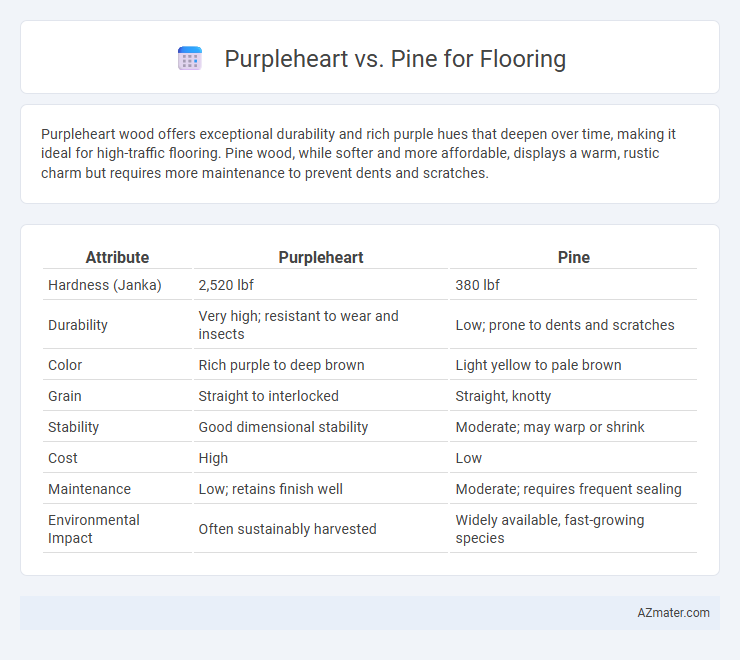Purpleheart wood offers exceptional durability and rich purple hues that deepen over time, making it ideal for high-traffic flooring. Pine wood, while softer and more affordable, displays a warm, rustic charm but requires more maintenance to prevent dents and scratches.
Table of Comparison
| Attribute | Purpleheart | Pine |
|---|---|---|
| Hardness (Janka) | 2,520 lbf | 380 lbf |
| Durability | Very high; resistant to wear and insects | Low; prone to dents and scratches |
| Color | Rich purple to deep brown | Light yellow to pale brown |
| Grain | Straight to interlocked | Straight, knotty |
| Stability | Good dimensional stability | Moderate; may warp or shrink |
| Cost | High | Low |
| Maintenance | Low; retains finish well | Moderate; requires frequent sealing |
| Environmental Impact | Often sustainably harvested | Widely available, fast-growing species |
Introduction to Purpleheart and Pine Flooring
Purpleheart flooring is known for its vibrant purple hue, exceptional hardness, and resistance to wear, making it a durable choice for high-traffic areas. Pine flooring offers a more traditional look with its warm tones and softer texture, providing a cost-effective and easy-to-install option. Both woods differ significantly in durability, color stability, and maintenance requirements, influencing the choice depending on aesthetic preference and usage needs.
Key Characteristics of Purpleheart Wood
Purpleheart wood is highly valued for flooring due to its exceptional durability, dense grain, and striking deep purple hue that darkens over time, offering a unique aesthetic appeal. Its resistance to wear, decay, and insect infestation makes it ideal for high-traffic areas compared to softer woods like pine. The wood's hardness rating on the Janka scale is approximately 2,520, significantly higher than pine's 380, ensuring longevity and strength under daily use.
Key Characteristics of Pine Wood
Pine wood is a softwood known for its light color, prominent grain patterns, and affordability, making it a popular choice for flooring in residential spaces. Its natural resin content provides moderate durability, though it is more prone to dents and scratches compared to hardwoods like Purpleheart. Pine's ease of staining and finishing allows for versatile design options, but maintenance is necessary to preserve its appearance and longevity.
Durability and Hardness Comparison
Purpleheart flooring boasts exceptional durability with a Janka hardness rating of approximately 2,520, making it one of the hardest domestic woods available, well-suited for high-traffic areas. Pine flooring, with a Janka hardness of about 690, is significantly softer and more prone to dents and scratches, requiring more maintenance and care. The dense, resilient nature of Purpleheart provides superior resistance to wear and impact compared to the softer, more porous Pine, ensuring long-lasting performance in flooring applications.
Appearance and Color Differences
Purpleheart flooring showcases a rich, deep purple hue that intensifies over time to a dark brownish-purple, offering a unique and exotic look compared to the more common light yellow to pale brown shades of Pine. Pine displays prominent knots and grain patterns that contribute to a rustic and warm appearance, while Purpleheart's fine, straight grain provides a smoother and more uniform texture. The vibrant and lasting color of Purpleheart stands out in modern or luxury interiors, whereas Pine's lighter tone and traditional character suit cozy, country-style or casual spaces.
Installation Challenges and Ease
Purpleheart flooring presents installation challenges due to its density and hardness, requiring specialized tools and pre-drilling for nails or screws to prevent splitting. Pine, being a softer wood, is easier to cut, nail, and shape, making it more suitable for DIY installations and reducing overall labor time. The durability of Purpleheart demands more precision during installation, while Pine's workability allows for faster and less complicated floor laying processes.
Maintenance and Longevity
Purpleheart flooring offers exceptional durability and resistance to wear, requiring minimal maintenance compared to Pine, which is softer and prone to dents and scratches. Pine floors need regular refinishing and careful cleaning to prevent damage, while Purpleheart's dense grain resists moisture and decay, enhancing its longevity. Choosing Purpleheart ensures a long-lasting, low-maintenance floor ideal for high-traffic areas, whereas Pine suits spaces with lighter use and more frequent upkeep.
Cost and Budget Considerations
Purpleheart flooring tends to be more expensive than pine due to its rarity and durability, with prices ranging from $8 to $15 per square foot compared to pine's $3 to $7 per square foot. Pine, being a softer and more abundant wood, offers a budget-friendly option suitable for cost-conscious projects and is easier to source in most regions. Choosing between Purpleheart and pine flooring depends largely on balancing upfront material costs with long-term value, as Purpleheart's density and resistance can reduce maintenance expenses over time.
Environmental Impact and Sustainability
Purpleheart flooring offers a sustainable option due to its dense, slow-growing nature from Central and South American forests where certified harvesting practices are increasingly enforced, reducing deforestation risks. Pine wood flooring, typically sourced from fast-growing temperate forests in North America, benefits from widespread reforestation efforts and carbon sequestration but may involve extensive chemical treatments to enhance durability. Both woods provide eco-friendly choices when certified by organizations like FSC, with Purpleheart boasting longer lifespan reducing replacement frequency and Pine supporting lower carbon footprints through rapid growth cycles.
Which Flooring Should You Choose?
Purpleheart flooring offers exceptional hardness and durability, with a Janka rating around 2,520 compared to Pine's softer 380 to 870, making it ideal for high-traffic areas needing long-lasting resilience. Pine provides a warm, rustic aesthetic and is more affordable but requires more maintenance due to its susceptibility to dents and scratches. Choose Purpleheart for longevity and exotic appeal, or Pine for budget-friendly, traditional charm with easier refinishing options.

Infographic: Purpleheart vs Pine for Flooring
 azmater.com
azmater.com